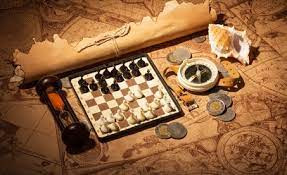Since time immemorial, sports and board games have been a significant part of India’s diverse culture, history, and heritage. Board games were mainly played for amusements and pleasures. However, there were also grave contests held among the Kings or the ministers. Winning those challenges needed clarity of thoughts, sharp judgment skills, or seldom, absolutely on luck alone.
History of Board Games in India
We find the references of several board games through the documentation of various notable historical figures. One of them was Ab-ul Fazl, the court historian of Akbar. He writes about the great Pachisi Courtyard, which was built by Akbar in the 16th century. This courtyard is a prominent and remarkable feature in the complex of Fatehpur Sikri.
Through archeological sources, some of the earliest evidence of board games can be traced from Indus Valley Civilisation. In the later years, the games like chaupar, chaturanga, backgammon developed and became popular among the masses. They also earned a respectable position in numerous court cultures throughout India.
As a matter of fact, across several other imperial courts of the world, the demand for Indian board games were quite high. For instance, the game of Chess, which originated in the North-Western part of India during the Gupta age, soon gained the moniker of ‘royal game’ in England. Likewise, pachisi got popularized as ‘Ludo’ in England and ‘Parcheesi’ in the U.S.A.
Materials Used In Board Games In Ancient India
Further studies reveal that even the Vedic period has witnessed the creation and progress of various board games. Although the studies cannot assert much about the rules of the games which were played then, it does yield some concepts about the materials being used.
It was during the Vedic period that people gradually began using long rectangular dice; though later cubic dice became widespread and popular. In the much later years, cowry shells came to use. It quickly earned prominence, especially among the common people.
The game boards were also crafted out from a variety of materials. Similar to the dice and other pieces of the games, the board materials gradually developed from slabs of stone and pieces of clothes to carved wood and long-legged tables with boards carved into them.
Picture Source: Chessopolis
Some Traditional Board Games and Their Strategies
- Backgammon:
One of the oldest known games of India, Backgammon quickly gained popularity throughout the Indian subcontinent. Its distinction can be noted from the famous carvings in the Ellora caves.
Involving a combination of strategy and fortune, this two-player game aims to bear off all the fifteen checkers off the board. Each player is supposed to move the checkers along twenty-four triangles based on the rolls of two dice.
- Moksha Patam (Snakes and Ladders):
This dice board game is based on sheer luck and is most popular among young children. Besides being a source of entertainment, Moksha Patam or Gyan Chauper also indulges in teaching the concept of liberation from captivity of passions.
According to dice rolls, the players compete to reach the finishing point where the ladders help climbing upwards and the snakes hinder the progress.
- Pachisi (Ludo):
Although originated much before the Mughal timeline, pachisi or chaupar reached its highest peak during this period. In the present day, this game is termed as ‘ludo’, though there are some rules which have transformed themselves over the years.
- Chaturanga (Chess):
Another of the Indian strategy game, Chaturanga earns its name from the formation of battle which has been mentioned in the Indian epic Mahabharata. This game is also believed to be an ancestor of modern games, such as chess.
The game is created in a battle-like setting, where the pieces form the divisions of an army, which include, chariots, elephants, cavalry, and infantry.
- Navakankari:
Also termed as ‘Nine Mens Morris’, Navakankari has its origin back in the Roman Empire era. The game involves two players, where the pieces need to be lined up horizontally or vertically. With optimum strategy, the players have to reduce the opponent’s pieces. If played perfectly by both the players, the game results in a draw. - Scrabble:
An interesting word game which engrosses the players to score points by placing the single letters on the game board to form a word. ? - Chowka Bara:
Originated in Kerala, India, Chowka Bara or Ashta Chamma is a two- or four-player board game, which is played by the roll of dice, and can be won on the basis of chance. - Ali Guli Mane:
Belonging to the mancala family of board games, Alu Guli Mane is also known as Chenne Mane in Coastal Karnataka, and Akal Patta in North Karnataka. The board looks distinct and interesting. The game illustrates an abstract strategy, where the players maintain the closest row of holes and aim to fill as many rows as possible. - Solitaire:
Generally called ‘Brainvita’ in India, this board game involves one player, where he has to move the pegs or the marbles in the board which consists of several holes. The aim of the game is to vacate the entire board, leaving one solitary peg in the central hole.
Gradually, over decades, these ancient Indian board games transcended the limitations of the court and crossed the threshold to enter the lives of ordinary folk. Their profound references can be found in court paintings, carvings in temple walls, epics, and literary works. The strategy and approach of such games play a momentous part in upholding Indian society in one broad sweep.
Picture Source: Chessopolis



